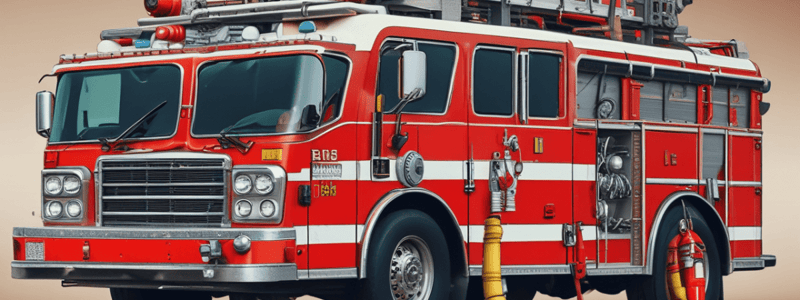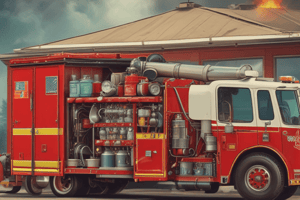Podcast
Questions and Answers
What should you do before switching to AWD if the rear wheels are spinning?
What should you do before switching to AWD if the rear wheels are spinning?
- Operate in reverse
- Press the top of the switch to engage AWD
- Shift into low gear
- Release the throttle (correct)
What happens when the AWD switch is on and the rear wheels lose traction?
What happens when the AWD switch is on and the rear wheels lose traction?
- The front gearcase will automatically disengage
- The front gearcase will automatically engage (correct)
- The vehicle will shift into low gear
- The 4X4 indicator will turn off
What should you do if the front gear case remains locked after turning the AWD switch off?
What should you do if the front gear case remains locked after turning the AWD switch off?
- Stop the vehicle and shift into park
- Operate in reverse for at least 10 feet (correct)
- Shift into low gear and drive forward
- Try to turn the AWD switch back on
Why is it recommended to lock the differential in slippery or low traction conditions?
Why is it recommended to lock the differential in slippery or low traction conditions?
What should you do before disengaging AWD?
What should you do before disengaging AWD?
What happens when the rear wheels regain traction in AWD mode?
What happens when the rear wheels regain traction in AWD mode?
What is the indicator that the vehicle is in AWD mode?
What is the indicator that the vehicle is in AWD mode?
What is the result of switching to AWD while the rear wheels are spinning?
What is the result of switching to AWD while the rear wheels are spinning?
What should you do if the winch motor becomes hot during winch use?
What should you do if the winch motor becomes hot during winch use?
What is the primary reason for not towing more than the recommended weight for the vehicle?
What is the primary reason for not towing more than the recommended weight for the vehicle?
How should you secure the tow strap during winching operations?
How should you secure the tow strap during winching operations?
What is the maximum tongue weight recommended for the towing bracket?
What is the maximum tongue weight recommended for the towing bracket?
Why is it important to wind the winch cable under tension for storage?
Why is it important to wind the winch cable under tension for storage?
What should you do when returning the apparatus to service after winching?
What should you do when returning the apparatus to service after winching?
What should you do when towing a trailer?
What should you do when towing a trailer?
Why is it essential to maintain tension on the winch cable during winching operations?
Why is it essential to maintain tension on the winch cable during winching operations?
What is the primary purpose of the Brush 24 (BT24)?
What is the primary purpose of the Brush 24 (BT24)?
According to the document, when should Brush 24 (BT24) be connected to CAR4 or an appropriate tow vehicle?
According to the document, when should Brush 24 (BT24) be connected to CAR4 or an appropriate tow vehicle?
What is the intended frequency for inspecting and testing the water pump and vehicle?
What is the intended frequency for inspecting and testing the water pump and vehicle?
What specific guideline outlines the response protocol for Brush Fire incidents?
What specific guideline outlines the response protocol for Brush Fire incidents?
When is it permissible to use the water pump on the Brush 24 (BT24) for hose testing?
When is it permissible to use the water pump on the Brush 24 (BT24) for hose testing?
What is the standard procedure for storing and transporting Brush 24 (BT24) when it is not in use?
What is the standard procedure for storing and transporting Brush 24 (BT24) when it is not in use?
What is the NIMS compliance status of the Brush 24 (BT24) Standard Operating Guidelines?
What is the NIMS compliance status of the Brush 24 (BT24) Standard Operating Guidelines?
What is the latest revision date for these Standard Operating Guidelines?
What is the latest revision date for these Standard Operating Guidelines?
What is the maximum allowable pressure for recirculating back into the tank?
What is the maximum allowable pressure for recirculating back into the tank?
Which valve should remain open during the initial setup process?
Which valve should remain open during the initial setup process?
What is the recommended duration to flood the piping using the primer button?
What is the recommended duration to flood the piping using the primer button?
What must be done before shutting down the pump system after using the foam agent?
What must be done before shutting down the pump system after using the foam agent?
When backing up the tow vehicle, what is essential to ensure safety?
When backing up the tow vehicle, what is essential to ensure safety?
What should be done to secure the trailer to the tow vehicle after lowering the coupler?
What should be done to secure the trailer to the tow vehicle after lowering the coupler?
What is the first step in the process of attaching the trailer?
What is the first step in the process of attaching the trailer?
Why must the foam not recirculate back into the tank?
Why must the foam not recirculate back into the tank?
What is the primary purpose of using All-Wheel Drive (AWD) when driving on a slope?
What is the primary purpose of using All-Wheel Drive (AWD) when driving on a slope?
During a winching operation, how should the winch cable be positioned to ensure proper spooling?
During a winching operation, how should the winch cable be positioned to ensure proper spooling?
What is the minimum amount of winch cable that should remain wrapped around the winch drum?
What is the minimum amount of winch cable that should remain wrapped around the winch drum?
What should be done to reduce the risk of injury during winch operations?
What should be done to reduce the risk of injury during winch operations?
What action should be avoided to prevent damaging the winch cable?
What action should be avoided to prevent damaging the winch cable?
Why is it important to inspect the winch cable before use?
Why is it important to inspect the winch cable before use?
What should be applied to prevent the vehicle from moving during winching?
What should be applied to prevent the vehicle from moving during winching?
What could be used as a damper during winch operations?
What could be used as a damper during winch operations?
Study Notes
Brush 24 (BT24) Operations
- The Brush truck is used to assist in extinguishing wildland fires and safely transport personnel, and can also be used for other emergency incidents.
Storage and Transportation
- Brush 24 (BT24) is secured on its trailer and checked out weekly when in quarters.
- If requested by CAD, Brush 24 (BT24) is connected to CAR4 or an appropriate tow vehicle and responds according to Response Guideline-17 Brush Fire.
Dry Pump and Tank
- The pump and tank are kept dry when in quarters.
- The water tank must be filled and the water pump primed if used for inspection, training, or an incident.
- Brush 24 (BT24) is not to be used for hose testing.
- The vehicle and water pump are inspected and tested on every Thursday of the month.
Operation of the Water Pump
- Check gas and oil levels before operating the water pump.
- Fill the tank with 67 gallons of water and 3 gallons of foam (if needed).
- Open the primer valve, tank to pump valve, and recirculate-fill valve.
- Insure all other valves are closed.
- Push the primer button to flood piping for approximately 30 seconds.
- Close the primer valve and start the pump.
- Turn the engine switch to the "ON" position or turn the key to the start position.
- Never recirculate over 50 PSI back into the tank.
- Open the desired discharge valve.
- Close the recirculate valve.
- Open the foam agent valve (if needed).
- Never allow foam to recirculate back into the tank.
Attaching the Trailer
- Raise the front of the trailer with the tongue jack.
- Back the tow vehicle until the coupler is over the hitch ball (always use back-up personnel to back-up any vehicle).
- Lower the trailer until the coupler completely covers the hitch ball using the tongue jack.
- Lock the coupler into place.
- Insure the trailer is locked on the tow ball by raising the front of the trailer (slightly) using the tongue jack.
- To stow the tongue jack, crank the tongue jack up, until it stops, pull the pivot release pin, and pivot the tongue jack into the traveling position.
- Cross the safety chains under the tongue and attach them to the tow vehicle.
- Connect the trailer wiring harness to the tow vehicle.
- Check trailer lights for proper operation.
- Check Brush 24 (BT24) tie-downs are secured to its trailer, confirm transmission is in PARK, keys are in the ignition, and all windows are closed, and any loose items are secured.
Shifting to All-Wheel Drive (AWD)
- Engage AWD before getting into conditions where front wheel drive may be needed.
- Press the top of the switch to engage AWD.
- The 4X4 indicator illuminates in the rider information center to indicate that the vehicle is in AWD.
- When the AWD switch is on, the front gearcase will automatically engage any time the rear wheels lose traction.
- When the rear wheels regain traction, the front gearcase will automatically disengage.
- There is no limit to the length of time the vehicle may remain in AWD.
- WARNING: Switching to AWD while the rear wheels are spinning may cause severe drive shaft and clutch damage.
Disengaging All-Wheel Drive (AWD)
- Slow the vehicle to nearly stopped before disengaging AWD.
- Move the AWD switch to the center or bottom position to disengage AWD.
- If the switch is turned off while the front hubs are driving, they will not release until the rear wheels regain traction.
- In some situations, the front gear case may remain locked after turning the AWD switch off.
Locking the Differential (2WD)
- Bring the vehicle to a stop before engaging the differential.
- Move the rocker switch to the center position to lock the differential and operate in two-wheel drive (2WD).
- Locking the differential in slippery or low traction conditions helps improve traction.
- When driving up or down a hill or slope, consider the use of AWD to reduce strain on the engine and aid in keeping wheel speed down, preventing the potential for slippage.
- Descend a hill in the same gear used to climb and avoid excessive braking.
Winch Operation
- Always inspect the vehicle, winch, winch cable, and winch controls for any signs of damage or parts in need of repair or replacement before each use.
- Apply the vehicle's park mechanism to hold the vehicle in place during winching.
- Use wheel chocks if needed.
- Release the winch clutch using the side selector and pull out the winch cable.
- Pulling out as much cable as possible maximizes the winch's pulling capacity.
- Always be sure that at least five (5) full turns of winch cable are wrapped around the winch drum at all times.
- Place a "damper" on the midpoint of the winch cable to absorb energy released if the winch cable breaks.
- Avoid being directly in line with the winch cable during winching.
- Never hook the winch cable back onto itself.
- Never use straps, chains, or other rigging items that are damaged or worn.
- The winch motor may become hot during winch use.
- Stop winching and permit the winch to cool down for 10 minutes before using it again if winching for more than 45 seconds or if the winch stalls during operation.
Towing Loads
- Never load more than 150 lbs. (68.1 kg) tongue weight on the towing bracket.
- When towing a disabled vehicle, place the disabled vehicle's transmission in neutral.
- Do not operate the vehicle faster than 10 MPH (16 km/h) when towing.
- Towing a trailer increases braking distance.
- Do not tow more than the recommended weight for the vehicle.
- Attach a trailer to the trailer hitch bracket only.
- Do not attach a trailer to any other location, which could result in loss of control of the vehicle.
Studying That Suits You
Use AI to generate personalized quizzes and flashcards to suit your learning preferences.
Description
This quiz covers the standard operating guidelines for Brush 24 (BT24) operations in the Hoffman Estates Fire Department.




